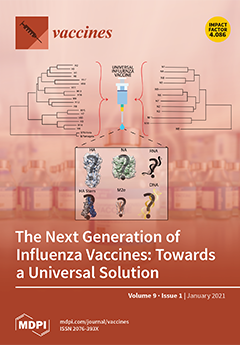The causative agent of acute hepatopancreatic necrosis disease (AHPND) is the bacterium,
Vibrio parahaemolyticus, which secretes toxins into the gastrointestinal tract of its host.
Vibrio parahaemolyticus toxins A and B (PirA
vp/PirB
vp) have been implicated in the pathogenesis of
[...] Read more.
The causative agent of acute hepatopancreatic necrosis disease (AHPND) is the bacterium,
Vibrio parahaemolyticus, which secretes toxins into the gastrointestinal tract of its host.
Vibrio parahaemolyticus toxins A and B (PirA
vp/PirB
vp) have been implicated in the pathogenesis of this disease, and are, therefore, the focus of studies developing treatments for AHPND. We previously produced recombinant antibodies based on the hagfish variable lymphocyte receptor B (VLRB) capable of neutralizing some viruses, suggesting that this type of antibody may have a potential application for treatment of AHPND. Here, recombinant PirA
vp/PirB
vp, produced using a bacterial expression system, were used as antigens to screen a hagfish VLRB cDNA library to obtain PirA
vp/PirB
vp-specific antibodies. A cell line secreting these antibodies was established by screening and cloning the DNA extracted from hagfish B cells. Supernatants collected from cells secreting the PirA
vp/PirB
vp antibodies were collected and concentrated, and used to passively immunize shrimp to neutralize the toxins PirA
vp or PirB
vp associated with AHPND. Briefly, 10 μg of PirA
vp and PirB
vp antibodies, 7C12 and 9G10, respectively, were mixed with the shrimp feed, and fed to shrimp for three days consecutive days prior to experimentally infecting the shrimp with
V. parahaemolyticus (containing toxins A and B), and resulting mortalities recorded for six days. Results showed significantly higher level of survival in shrimp fed with the PirB
vp-9G10 antibody (60%) compared to the group fed the PirA
vp-7C12 antibody (3%) and the control group (0%). This suggests that VLRB antibodies may be a suitable alternative to immunoglobulin-based antibodies, as passive immunization treatments for effective management of AHPND outbreaks within shrimp farms.
Full article






